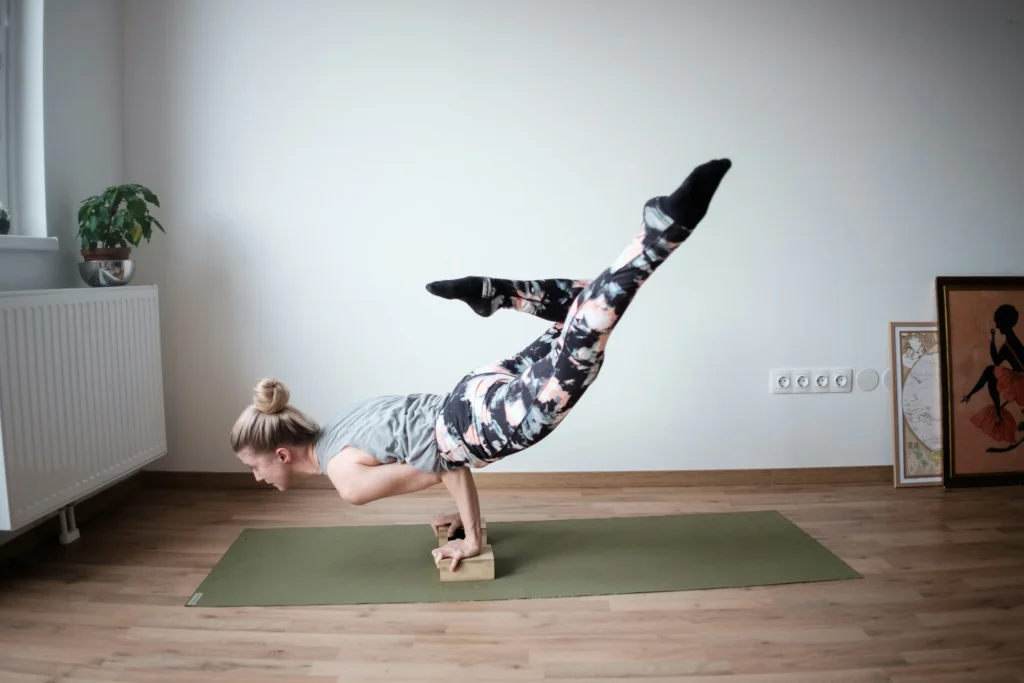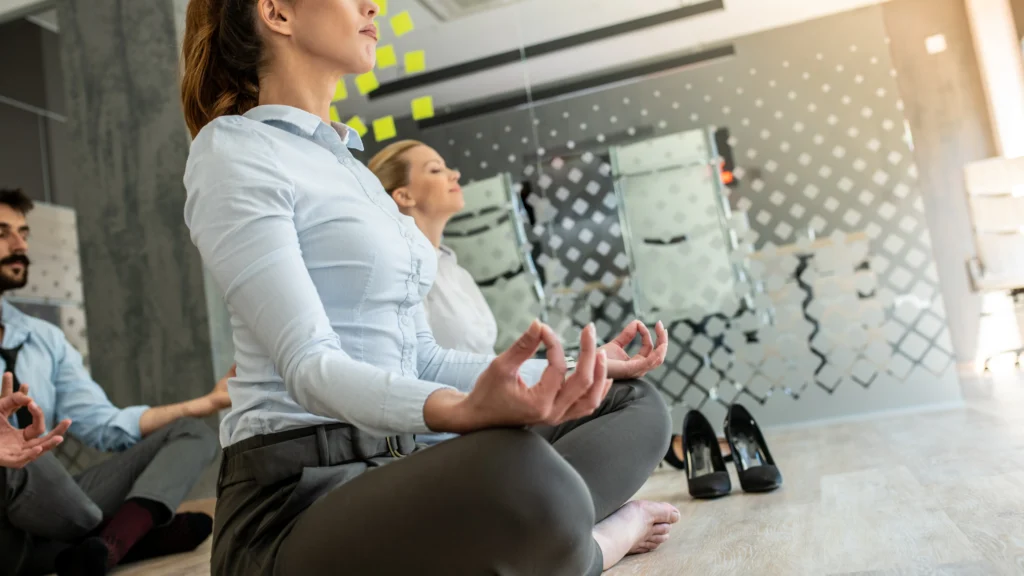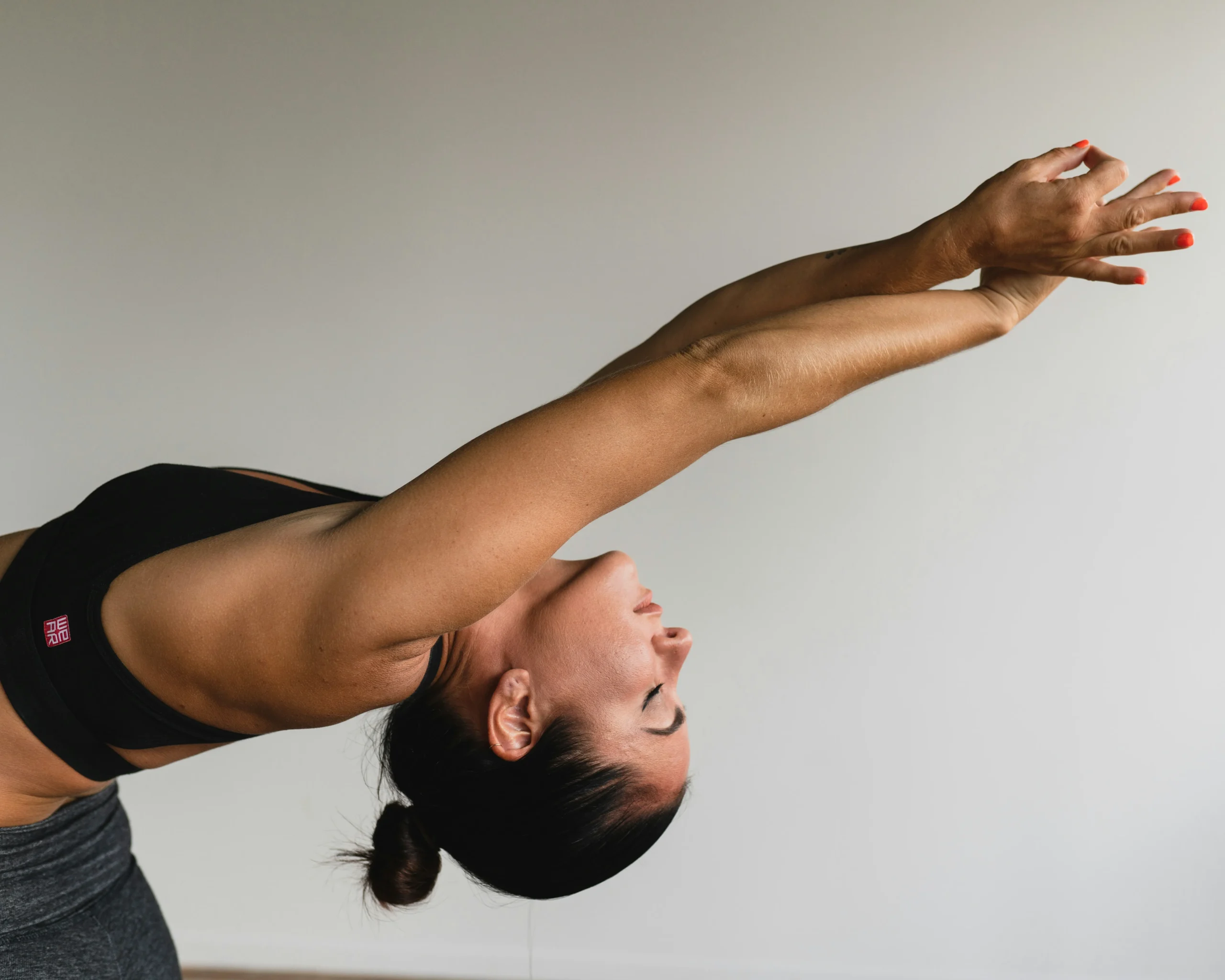Hey there, friend! 🌟 Are you your own toughest critic? We’ve all been there—second-guessing every decision, replaying mistakes, and sprinkling our day with a little too much self-doubt. Whether you’re fretting over a past conversation or just feeling down about not meeting your own sky-high standards, it’s time to pause and breathe. Yes, really, take a deep breath in! 🌿
In this post, we’re getting into how yoga isn’t just about twisting yourself into a pretzel—it’s a secret weapon against that pesky inner critic. So, if you’re ready to swap self-criticism for self-compassion, stick around. Yoga might just be the game-changer you need. Let’s roll out that mat and roll in some serious self-love vibes! 🧘♀️💖
Table of Contents
Section 1: Understanding Self Criticism

What Exactly is Self Criticism and Why Are We All So Good at It?
Ever wonder why we’re all so great at beating ourselves up? 🤔 Let’s break it down! Self criticism is that inner voice that says you’re not enough, whether it’s smart enough, fast enough, or anything-else-enough. It’s like having a tough-love coach in your head that sometimes just gets a bit… too tough. We’ll dive into why our brains love to focus on the negatives and how it’s actually a weird survival tactic gone rogue!
The Sneaky Ways Self Criticism Affects Your Day-to-Day
This isn’t just about feeling blue after a bad day. Self criticism can sneak into every corner of your life, from making you feel anxious at social events to stopping you from trying that cool new hobby. Did you snap at someone because you were feeling bad about yourself? Or maybe you skipped out on a social event? Yep, that’s your inner critic, turning small things big and bright days gray.
How Our Bodies React to Being Our Own Worst Enemy
Believe it or not, being hard on yourself can do more than just ruin a good mood—it can actually affect your body. Stress headaches, trouble sleeping, or even just feeling tired all the time can all be signs that self criticism is getting to you. Let’s get real about how knocking yourself can knock out your physical health, and why turning off that negativity can mean not just feeling better, but feeling healthier.
Understanding self-criticism is the first step in managing it. By recognizing these patterns and reactions, we can start to take control and push back against the critical voices in our head. And guess what? Yoga is one of the best tools for this job! Stay tuned to learn how to use yoga to quiet that inner critic and boost your self-esteem.
Section 2: The Wisdom of Yoga for Personal Growth

Unpacking the Philosophy of Yoga: More Than Just Poses
When many people think of yoga, they imagine complex poses and deep stretches. However, yoga encompasses far more than physical exercise; it’s a profound philosophy that has been nurturing mind, body, and spirit for thousands of years. Here’s how the philosophy of yoga extends beyond the mat and can transform your life.
Roots in Ancient Wisdom
Yoga’s origins trace back to ancient Indian scriptures known as the Vedas, from which yoga derives its practices and ethical principles. Central to yoga philosophy is the pursuit of Moksha, or liberation, which is achieved through self-discipline, moral strength, and the pursuit of truth.
The Eight Limbs of Yoga
At the heart of yoga philosophy are the Eight Limbs, outlined in the Yoga Sutras of Patanjali. These serve as a guide to living a meaningful and purposeful life:
- Yamas (Restraints) – Ethical standards that include non-violence, truthfulness, non-stealing, continence, and non-covetousness.
- Niyamas (Observances) – Self-disciplines including purity, contentment, self-discipline, self-study, and surrender to a higher power.
- Asana (Postures) – The physical poses we most commonly associate with yoga, intended to prepare the body for meditation.
- Pranayama (Breath Control) – The practice of controlling the breath, which is believed to cleanse the body and calm the mind.
- Pratyahara (Withdrawal of Senses) – Encourages withdrawal from external distractions to increase spiritual awareness.
- Dharana (Concentration) – The practice of focusing concentration on a single meditative object.
- Dhyana (Meditation) – The uninterrupted flow of concentration, which allows for a deeper meditative state.
- Samadhi (Bliss or Enlightenment) – The ultimate stage of yoga, achieved through consistent meditation, leading to a union with the divine.
Living Yoga Beyond the Mat
Incorporating the principles of yoga into everyday life means more than attending regular classes. It involves embracing a way of living that fosters harmony in all actions, thoughts, and words.
- Practicing Yamas and Niyamas can guide your interactions with others and with yourself, leading to a more peaceful and centered existence.
- Daily Meditation and Pranayama can improve mental clarity and reduce stress, helping you to maintain emotional and psychological balance.
- Asanas for Everyday Wellness not only keep the body healthy but also discipline the mind, teaching patience and perseverance.
Yoga as a Tool for Modern Life
Yoga is more than just a physical practice; it’s a profound journey of self-discovery and introspection. Each movement and breath is an opportunity to connect more deeply with the inner self. Here’s how yoga serves as a powerful tool for reflection, helping to illuminate the path to personal growth and self-understanding.
The Meditative Aspect of Yoga
At its core, yoga is a meditative practice that enhances mindfulness and centers the mind. The quiet and focused moments on the mat create an ideal environment for reflection.
- Mindful Movement: Yoga poses require attention to body alignment and breath, which naturally brings the mind to a focused state, reducing external distractions and fostering an intimate space for self-reflection.
- Flow Sequences: Sequences like the Sun Salutation synchronize movement with breath, encouraging a meditative flow state where insights can surface naturally.
Introspection Through Pranayama
Breathing exercises, or Pranayama, are not merely about controlling breath; they are about harnessing energy and calming the mind, setting the stage for deeper introspection.
- Observational Breathing: Techniques like observing the natural inhalation and exhalation can help in noticing the subtle ways in which the mind reacts to different situations, leading to greater self-awareness.
- Balancing Energy: Practices such as Nadi Shodhana (alternate nostril breathing) balance the body’s energies, which can lead to a clearer and more reflective state of mind.
Read more about Why Pranayamas Are Better Than You’d Think? The Emotion Regulation.
Using Asanas to Explore Inner Dialogues
Different yoga poses can evoke different emotions and thoughts, making them useful tools for uncovering hidden feelings and internal narratives.
- Challenging Poses: Positions that challenge us physically can also challenge our mental resilience, revealing our inner dialogue around struggle and endurance.
- Restorative Poses: Gentle and holding poses allow for pause and are conducive to exploring deeper emotional states, helping to uncover areas of tension or resistance within the psyche.
Yoga Nidra: The Sleep of the Yogis
Yoga Nidra, or yogic sleep, is a guided meditation technique performed in a state of deep relaxation. This practice is particularly powerful for self-reflection as it accesses the subconscious mind, allowing for a unique exploration of deep-seated thoughts and feelings.
- Sankalpa (Intention): Setting a personal intention or resolve during Yoga Nidra helps focus the subconscious exploration, providing insights into personal aspirations and obstacles.
Journaling Post-Practice
After a yoga session, taking time to journal can significantly enhance the reflective process. Writing down thoughts, emotions, and physical sensations that arose during practice can provide clarity and a record of personal growth over time.
- Reflective Prompts: Use specific questions to delve deeper, such as “What emotions did I feel during my practice today?” or “What thoughts kept recurring during meditation?”
Integrating Yoga Reflections into Daily Life
The insights gained from yoga can be transformative when applied to everyday life. Reflective practices encourage a mindful approach to personal interactions, decision-making, and self-care.
- Mindful Choices: Using reflections from yoga to guide daily decisions can lead to more aligned and authentic living.
- Emotional Resilience: The self-awareness developed through yoga can improve emotional management, helping to navigate life’s ups and downs with grace and poise.
Continued Practice for Deepened Insights
Consistency in yoga practice is key to deepening the quality of reflection. Over time, as familiarity with the body and mind increases, so does the depth of insight into personal patterns and behaviors.
Yoga offers a unique and powerful pathway to self-reflection, opening doors to inner worlds often left unexplored. Through its practices, individuals are equipped not only to face the external world with strength but also to understand and shape their inner landscapes with compassion and wisdom.
The Self-Acceptance Posture: How Yoga Builds Inner Strength
It’s not just about physical strength—yoga builds emotional resilience, too. Each pose is a challenge to overcome self criticism, not just physically but mentally. Struggling to hold that Warrior II? Yoga teaches you to acknowledge your limits without judgment and to be patient with yourself as you grow. This section will show you how these practices reinforce self-acceptance and encourage us to celebrate every little victory on the mat and in life. 🧘♂️🎉
Embracing Imperfection Through Asanas
Yoga poses, or asanas, are not just physical exercises; they are lessons in patience and acceptance. Each posture challenges us to confront our body’s limitations and embrace them. Unlike other forms of exercise that often focus on pushing beyond limits, yoga teaches acceptance of where you are today.
- Warrior Poses: These poses exemplify strength and stability. As you hold a Warrior pose, you’re not just building muscle—you’re cultivating an attitude of courage and acceptance of your current physical and mental state.
- Balancing Poses: Poses like Tree or Half Moon pose require balance and focus. They teach acceptance by making you aware of your body’s fluctuations and the need to adjust gently, fostering a forgiving attitude towards falls and wobbles.
Yoga’s Philosophy on Inner Strength
The philosophical aspect of yoga teaches that true strength comes from within. This involves understanding and nurturing our mental and emotional states, not just our physical bodies.
- Ahimsa (Non-violence): This principle isn’t only about refraining from physical harm but also about being gentle with ourselves in thought and action. Practicing ahimsa encourages us to treat ourselves with kindness, especially in thoughts, reducing self-criticism and promoting self-acceptance.
- Santosha (Contentment): Santosha invites us to find contentment in the present moment and with ourselves as we are. This acceptance does not mean complacency; rather, it encourages a positive mindset from which growth can occur.
Mindfulness and Self-awareness in Practice
Mindfulness is a core component of yoga that enhances self-awareness and promotes a deep, enduring sense of inner peace. Through regular practice, yogis learn to observe their thoughts and emotions without judgment, understanding their transient nature and learning not to define themselves by temporary states or external achievements.
- Meditation and Reflection: Postures and breathing exercises often lead into meditation, where the lessons of the yoga mat are internalized. This reflective practice helps solidify feelings of self-worth and acceptance.
The Role of Breath in Building Inner Strength
Pranayama, or breath control, plays a crucial role in managing internal energies and emotions. Techniques like Ujjayi breath not only keep the physical body steady and strong but also soothe the mind and reduce anxiety.
- Breathing Through Challenges: Learning to maintain calm, steady breathing during difficult poses teaches resilience and control, which translates into handling life’s challenges with a similar demeanor.
Section 3: Integrating Yoga into Daily Life

Yoga on the Go: Quick Practices for Busy Bees
Who says you need a full hour to benefit from yoga? Not us! Dive into quick, impactful practices that fit into your schedule no matter how hectic it is. We’re talking about five-minute stretches at your desk, breathing exercises during your commute, or a quick meditation session before bed. Discover how these snippets can significantly reduce self-criticism and keep you grounded throughout the day.
Read more about 7 Best Yoga Stretching Exercises for Busy People.
Mindful Moments: Using Yoga Principles Throughout the Day
Yoga isn’t just about the time spent on your mat; it’s about carrying its lessons with you everywhere you go. Learn how to apply yoga’s mindfulness to daily activities like eating, walking, or even during conversation. We’ll show you how being present can transform mundane activities into opportunities for growth and self-reflection, helping you to live more consciously and less critically.
Stress-Busting Yoga Breaks at Work
Feeling overwhelmed at the office? Let’s turn your workspace into a peace zone. This section will guide you through discreet yoga poses and breathing exercises designed to be done right at your desk. Not only will these techniques help manage stress, but they’ll also increase your focus and productivity—plus, they’re so stealthy, your coworkers won’t even notice!
Aligning Your Environment with Yoga Vibes
Create a space that echoes the peace and balance of yoga. Whether it’s at home or a small corner of your office, setting up a dedicated space for yoga can inspire regular practice and a constant reminder to check in with yourself. Tips on minimalistic, calming décor ideas and how to keep your yoga space inviting and ready for a quick session will help make yoga a natural part of your environment and your day.
Yoga as a Social Activity
Yoga doesn’t have to be a solitary practice. Involve your friends, family, or colleagues by organizing group yoga sessions. Not only is it fun, but it also helps build a supportive community around your practice. We’ll discuss ways to make yoga a bonding activity that encourages collective well-being and helps everyone manage their inner critic together.
Incorporating Yoga into Your Evening Wind-down Routine
End your day as peacefully as it started by integrating yoga into your nighttime routine. A gentle session can help decompress the day’s stress and prepare your body and mind for a restful sleep. We’ll explore soothing poses and calming breathing techniques that help release tension and promote a sense of relaxation that combats nighttime self-criticism.
Committing to a Daily Yoga Practice
Consistency is key when it comes to any personal growth practice, especially yoga. We’ll wrap up with motivational tips to keep you committed to daily yoga, helping you transform it from an occasional activity into a vital part of your everyday life. Learn how to set achievable yoga goals and track your progress to maintain motivation and witness the transformative power of regular practice.
Through these practical steps, yoga can become more than just a practice—it becomes a lifestyle. These strategies ensure that yoga’s positive effects ripple throughout your entire day, helping you lead a more mindful, balanced, and critic-free life. Let’s take these teachings off the mat and into the world!
Section 5: Long-term Benefits of Yoga on Personal Growth

A Lifetime of Increased Self-Awareness
Embarking on a yoga journey opens the door to deeper self-awareness. Over time, regular practice helps you tune into your thoughts and emotions, allowing you to recognize patterns of self-criticism and address them proactively. Discover how sustained yoga practice can enhance your understanding of yourself and lead to significant personal transformation.
Building Resilience Against Stress
One of yoga’s superpowers is its ability to help us cope with stress more effectively. By integrating yoga into your life, you develop a resilience that buffers you against day-to-day stresses and the larger challenges life throws your way. This section explores how the stress-reduction techniques learned in yoga can lead to a calmer, more composed you, even in the face of adversity.
Enhanced Emotional Regulation
Yoga teaches more than just physical flexibility; it encourages emotional flexibility as well. Through practices like breath control and meditation, you gain tools for managing your emotions, leading to better outcomes in managing anger, frustration, and sadness. We’ll delve into how yoga helps you stay balanced and less reactive, transforming how you navigate emotional challenges.
Improved Physical Health and Vitality
The benefits of yoga extend well beyond mental and emotional improvements; they include physical health gains too. Regular yoga practice can improve your posture, enhance your flexibility, and strengthen your muscles. More importantly, these physical benefits contribute to an overall sense of well-being, which can positively impact your mental health and decrease self-criticism.
Sustained Growth in Personal Relationships
Yoga’s emphasis on mindfulness and compassion doesn’t just affect how you treat yourself—it also influences your interactions with others. Learn how the patience, understanding, and kindness you cultivate towards yourself can be extended to your relationships, leading to more meaningful and supportive connections.
Cultivating a Lifetime Habit of Health and Harmony
Finally, we look at how to maintain and deepen your yoga practice over a lifetime. As your journey evolves, so will your practices and the benefits you reap. Tips on adapting your yoga practice as you age, explore new techniques, and expand your understanding of yoga will ensure that it remains a rewarding part of your lifelong quest for growth and well-being.
In this section, we celebrate how yoga isn’t just a hobby or a fitness regimen—it’s a lifelong journey that enriches your existence in profound ways. By embracing yoga, you commit to a path of continuous personal growth, where the journey itself becomes as rewarding as any destination. Let’s keep moving forward, one pose at a time.
How to Overcome Self Criticism? Easy Tips You Can Apply Today!
- Forgive Your Past Mistakes.
- Focus on What You Can Improve. And Accept What You Can’t.
- Get a Clear Vision Where You Want to Be. Find People Who Have Already Done What You’re Trying to Do.
- Start Taking Small Steps Towards Progress. Don’t be Afraid to Ask For Help.
- It’s Okay to Make Mistakes Along the Way. The Important Part is Recognizing the Mistakes and Getting Back on the Path!
For more easy and applicable life wisdom tips, follow me on Instagram. I share daily inspirational and mindful posts to ignite the fire within you and help you meet your true self without judgment.
Conclusion of How to Overcome Self Criticism
Congratulations on embarking on this transformative journey of how to overcome self criticism with yoga! We’ve explored the immense potential yoga holds for personal growth, from mastering the art of self-compassion to integrating mindfulness into your daily routine.
Remember, the practice of yoga is not just about achieving perfect poses but embracing a lifestyle that fosters growth, resilience, and harmony within yourself and with the world around you. As you continue to practice how to overcome self criticism, stay curious, be patient with yourself, and enjoy each moment of discovery along the way. Here’s to a more mindful, peaceful, and self-compassionate you!
Additional Resources
Recommended Yoga Resources
For those who want to dive deeper into yoga, check out these books, apps, and websites:
- Books: “Light on Yoga” by B.K.S. Iyengar, “The Heart of Yoga” by T.K.V. Desikachar
- Apps: Down Dog, YogaGlo, Headspace for meditation and guided sessions
- Websites: Yoga Journal, DoYogaWithMe for tutorials, articles, and more
Join Our Community Board!
Join our community board where readers share their yoga journeys, tips, and experiences. It’s a place to connect, find motivation, and inspire others with your story!
FAQ Section
Q1: How often should I practice yoga to see benefits?
Practicing yoga can be flexible; even a few minutes daily can have positive effects. However, a regular practice of 3-5 times a week is recommended for more significant and lasting benefits.
Q2: Can I do yoga if I’m not flexible?
Absolutely! Yoga is for everyone, regardless of flexibility. Yoga improves flexibility over time, so don’t worry about your starting point.
Q3: What type of yoga is best for beginners?
Hatha yoga is great for beginners because of its slower pace and focus on basic poses and breathing techniques. Vinyasa or Ashtanga can be options as you gain more confidence.
Q4: Is yoga enough for physical exercise?
Yoga can be a complete fitness regimen, but it depends on what type you practice. More dynamic styles like Vinyasa or Ashtanga provide cardiovascular and strength-building benefits. Combining yoga with other activities can also be beneficial.
Q5: How can I make sure I’m doing the poses correctly?
It’s a good idea to attend a class or use video resources when you’re starting. As you become more familiar with the movements, listen to your body and adjust as needed.
This comprehensive guide aims to provide you with all the tools and information needed to integrate yoga into your life effectively and enjoy its many benefits. Keep exploring, practicing, and growing—your yoga journey has just begun!




